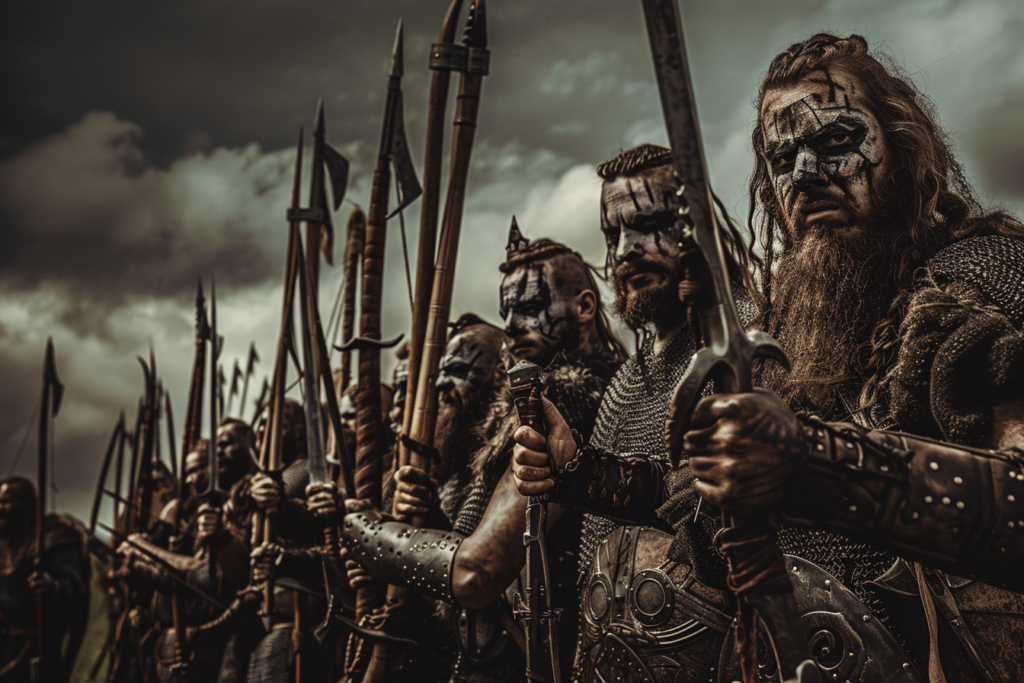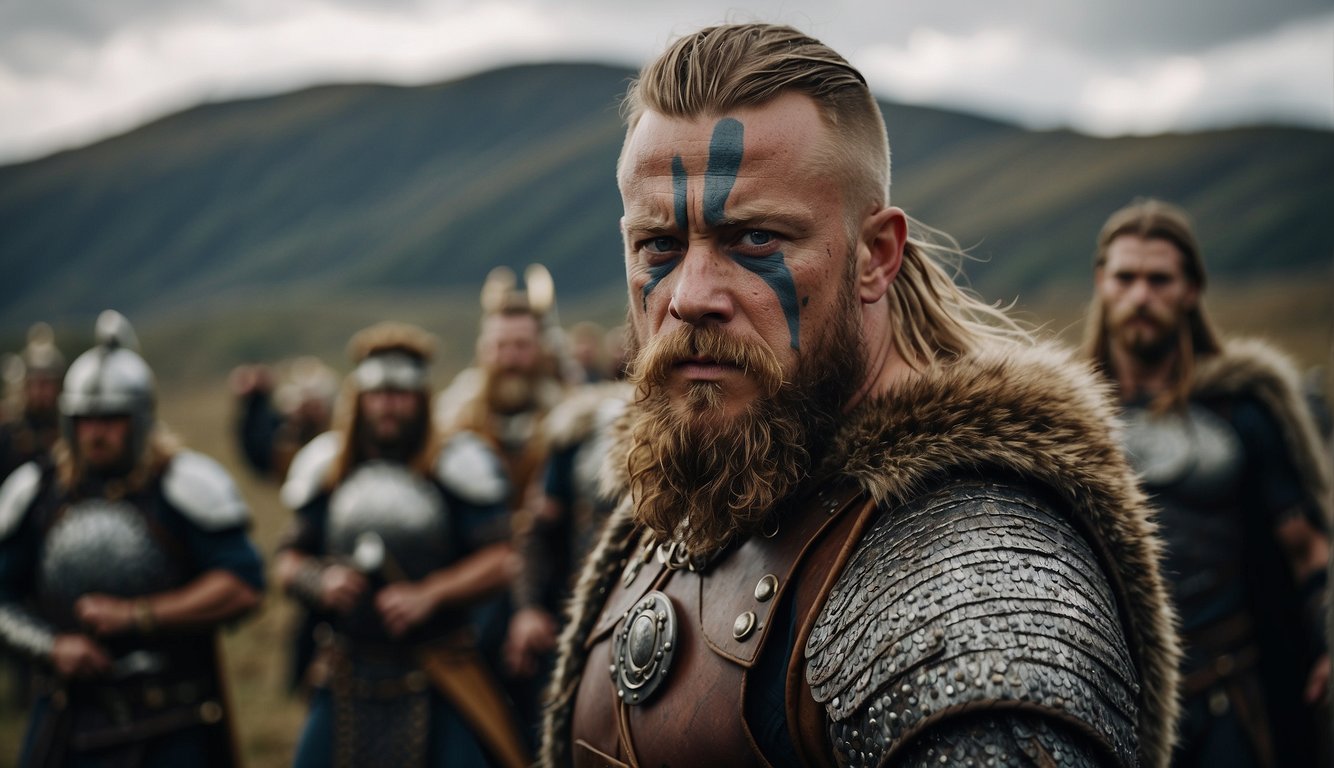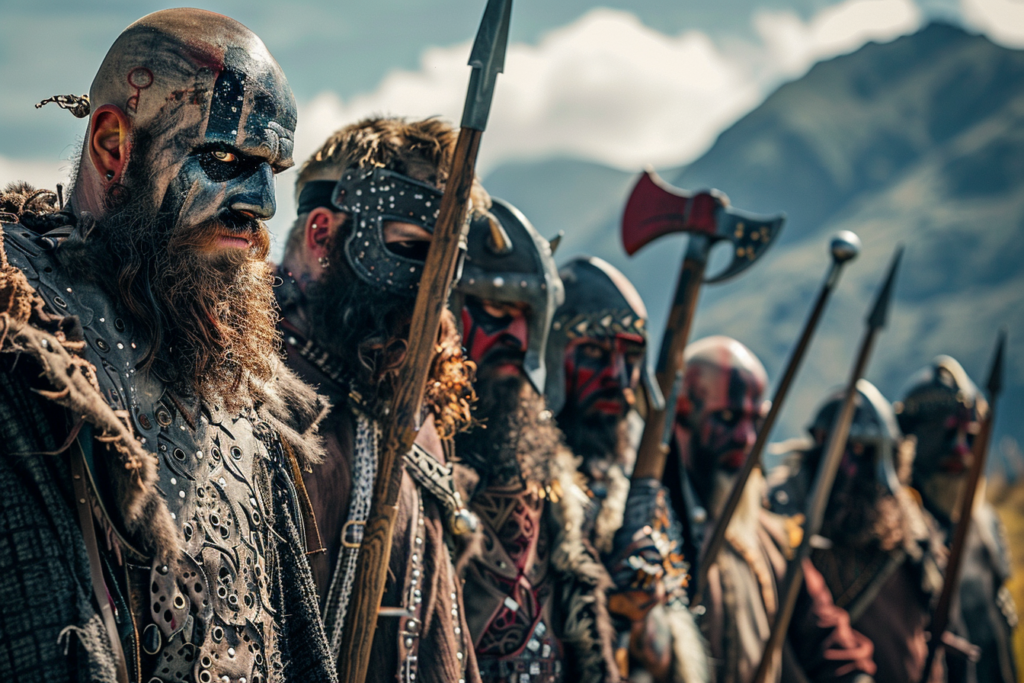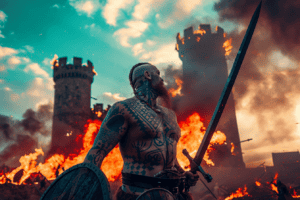Viking warriors were known for their fierce reputation on the battlefield. They instilled fear in their enemies, and their war paint was a significant part of their psychological warfare.

The Vikings used war paint to intimidate their enemies and to channel their inner ferocity in battle.
The ingredients used in making Viking war paint varied, with common components including plant-based pigments, minerals, and animal fats.
The designs and colors used in the war paint were also symbolic and held a profound significance in Viking culture.
For example, the Valknut, a mysterious interlocking triangle knot, was believed to grant protection and guidance to warriors in the heat of battle, ensuring their safe passage to the warrior’s paradise, Valhalla.
In this article, we will explore the significance of Viking war paint, its symbols, and the psychology behind it.
We will delve into the Viking age and culture to understand how war paint was used in battle and its importance in Viking tradition.
By examining historical texts and artifacts, we will gain insight into the meanings behind Viking face paint designs and colors and how they played a role in psychological warfare.
Historical Context and Evidence

Viking War Paint in the Middle Ages
During the Middle Ages, the Vikings were known for their fierce and brutal battles. They used various tactics to intimidate their enemies, one of which was the use of war paint.
The Vikings believed that war paint had the power to protect them in battle, and it was also used to show support for a particular cause or leader.
Historians have suggested that the Vikings used different types of war paint, depending on the occasion.
For example, they used red paint to symbolize blood and ferocity, while black paint was used to create a more ominous and intimidating appearance.
Archaeological Findings and Artifacts
Archaeological findings and artifacts have provided some evidence of the use of war paint by the Vikings.
For example, excavations at the Viking settlement of Hedeby in Germany have uncovered fragments of pottery that were used to hold cosmetic substances, including red ochre, a common ingredient in war paint.
Additionally, some Viking artifacts, such as helmets and shields, have been found with traces of red pigment, suggesting that they were once painted with war paint.
However, it is important to note that the use of war paint by the Vikings is still a subject of debate among historians, and there is no concrete evidence to support the claim that it was a common practice.
Cultural Significance and Symbolism

Viking war paint, also known as “berserker paint,” was more than just a cosmetic adornment for the Norse warriors. It held a rich cultural significance, connecting them to their mythology, gods, and beliefs.
The symbols and colors used in the war paint were carefully chosen to convey messages of strength, protection, and intimidation to their enemies.
Connection to Norse Mythology
Norse mythology played a significant role in the Viking culture, and the war paint was no exception.
The warriors believed that by painting their bodies before battle, they could channel the power of their gods, particularly Thor and Odin.
These gods were associated with strength, courage, and protection, and the warriors hoped to embody these qualities in battle.
Symbols of Strength and Protection
The symbols used in Viking war paint were also chosen for their meanings.
For example, the Helm of Awe was a popular symbol used in the war paint. It was believed to create a mystical aura around the warrior, intimidating adversaries and enhancing their combat abilities.
The symbol of the Valknut, a knot of three interlocking triangles, was also used in the war paint. It was associated with Odin and represented the afterlife, protection, and strength.
Rituals and Religious Festivals
Viking war paint was not just used in battle but also during rituals and religious festivals.
The warriors would paint their bodies in preparation for these events, hoping to gain favor from the gods and ensure a successful outcome.
Fertility festivals were also a common occasion for the use of war paint. The warriors would paint their bodies with symbols of fertility and protection, hoping to bring good fortune to their crops and livestock.
Psychology and Intimidation Tactics

Viking war paint was not just a cosmetic addition to the warriors’ attire. It had a significant psychological impact on both the wearer and the enemy. The following subsections will explore the psychological effects of Viking war paint in battle.
Instilling Fear in Enemies
The Viking war paint was designed to intimidate the enemy. The warriors used it to appear more ferocious and frightening in battle.
The paint’s design and application were often specific to the warrior’s clan or leader, making it a symbol of loyalty and strength.
The sight of a group of warriors with their faces painted in different designs and colors could have been terrifying to the enemy.
War Paint and Warrior Spirit
Viking war paint was not just about intimidation; it also played a crucial role in boosting the warrior’s morale.
The act of applying war paint was a ritual that helped the warrior connect with their inner warrior spirit. It was a way of preparing for battle and channeling their aggression and ferocity.
The paint’s ingredients, such as animal fats and minerals, also had symbolic meanings that were believed to offer protection and strength to the wearer.
Materials and Techniques

Natural Ingredients Used for War Paint
The use of natural ingredients for Viking war paint was a common practice among the Norse warriors.
They used a variety of materials to create their war paint, including pigments, ash, bone, kohl, woad, charcoal, lead carbonate, white lead, black powder, lead sulfide, and antimony sulfide.
Pigments were derived from plants, minerals, and animal products. They were crushed and mixed with animal fat to create a paste that could be applied to the skin.
Ash and bone were used to create a white pigment, while kohl was used to create a black pigment. Woad was used to create a blue pigment, and charcoal was used to create a black pigment.
Lead carbonate was used to create a white pigment, while lead sulfide and antimony sulfide were used to create a black pigment.
Application Methods and Tools
The application of Viking war paint was an important part of the warrior’s preparation for battle. They used a variety of tools to apply the war paint, including brushes, fingers, and sticks.
The paint was applied in a variety of patterns and designs, depending on the warrior’s preference.
The war paint was applied to the face, arms, and chest, and sometimes to other parts of the body. The designs and patterns used in the war paint were often symbolic and held special meaning for the warrior.
They were intended to intimidate the enemy and to give the warrior a psychological advantage in battle.

![What Was the Significance of Viking War Paint? [Symbols and Psychology in Battle]](https://historyexplained.org/wp-content/uploads/2024/05/vikingwarpaint4-1320x880.png)








Add Comment